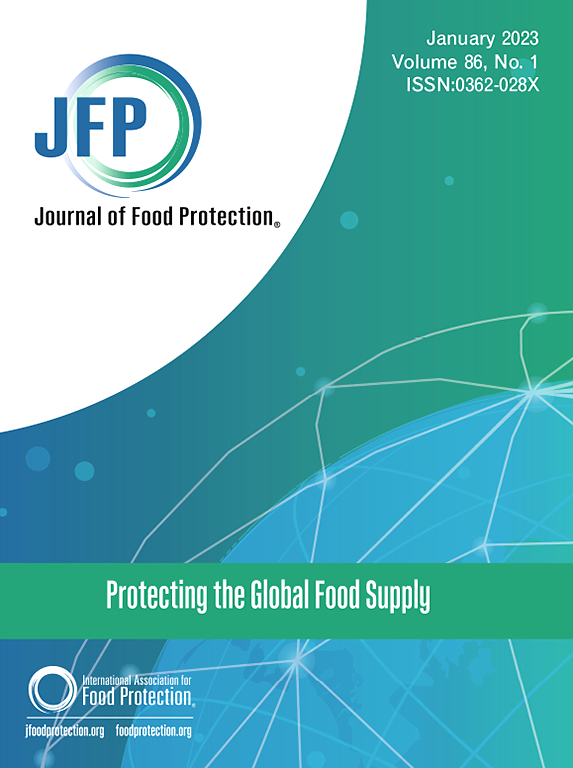Risk Categorization of Foods of Non-Animal Origin Subject to United Kingdom Import Controls
IF 2.1
4区 农林科学
Q3 BIOTECHNOLOGY & APPLIED MICROBIOLOGY
引用次数: 0
Abstract
Significant volumes of foods are traded between countries, and this trade brings with it opportunities for foodborne hazards to cross borders and pose a public health risk. The Competent Authority in the importing country has a duty to protect its population from these foodborne hazards. Due to the high volumes of imported food as well as World Trade Organization requirements, border checks need to be prioritized in a risk-based manner. This represents an enormous practical challenge to which efficient solutions are required. This paper describes an approach to risk categorization and ranking of imported Foods of Non-Animal Origin on a food/country of origin/hazard (combination) basis. Combinations were scored using data on product characteristics, hazard characteristics, and import volumes, with weightings applied following external consultation. The described approach differs from most others in that it categorizes and ranks microbiological, mycotoxin, and chemical hazards with a single approach and on the same scale, allowing for meaningful comparison between the combinations. The output is a risk categorization, a relative risk ranking and a heat map, all of which provide information that can be used alongside other data by risk managers when prioritizing interventions at the border.
受英国进口管制的非动物来源食物的风险分类。
各国之间进行大量食品贸易,这种贸易为食源性危害跨越国界并构成公共卫生风险带来了机会。进口国主管当局有责任保护其人口免受这些食源性危害。由于大量进口食品以及世界贸易组织的要求,需要以基于风险的方式优先考虑边境检查。这是一个巨大的实际挑战,需要有效的解决办法。本文介绍了一种基于食品/原产国/危害(组合)对进口非动物源性食品进行风险分类和排序的方法。使用产品特性、危害特性和进口量数据对组合进行评分,并在外部咨询后进行加权。所描述的方法与大多数其他方法的不同之处在于,它以单一方法和同一尺度对微生物、霉菌毒素和化学危害进行分类和排名,允许在组合之间进行有意义的比较。输出是风险分类、相对风险排名和热图,所有这些都提供了信息,风险管理人员在确定边境干预措施的优先次序时可以与其他数据一起使用。
本文章由计算机程序翻译,如有差异,请以英文原文为准。
求助全文
约1分钟内获得全文
求助全文
来源期刊

Journal of food protection
工程技术-生物工程与应用微生物
CiteScore
4.20
自引率
5.00%
发文量
296
审稿时长
2.5 months
期刊介绍:
The Journal of Food Protection® (JFP) is an international, monthly scientific journal in the English language published by the International Association for Food Protection (IAFP). JFP publishes research and review articles on all aspects of food protection and safety. Major emphases of JFP are placed on studies dealing with:
Tracking, detecting (including traditional, molecular, and real-time), inactivating, and controlling food-related hazards, including microorganisms (including antibiotic resistance), microbial (mycotoxins, seafood toxins) and non-microbial toxins (heavy metals, pesticides, veterinary drug residues, migrants from food packaging, and processing contaminants), allergens and pests (insects, rodents) in human food, pet food and animal feed throughout the food chain;
Microbiological food quality and traditional/novel methods to assay microbiological food quality;
Prevention of food-related hazards and food spoilage through food preservatives and thermal/non-thermal processes, including process validation;
Food fermentations and food-related probiotics;
Safe food handling practices during pre-harvest, harvest, post-harvest, distribution and consumption, including food safety education for retailers, foodservice, and consumers;
Risk assessments for food-related hazards;
Economic impact of food-related hazards, foodborne illness, food loss, food spoilage, and adulterated foods;
Food fraud, food authentication, food defense, and foodborne disease outbreak investigations.
 求助内容:
求助内容: 应助结果提醒方式:
应助结果提醒方式:


